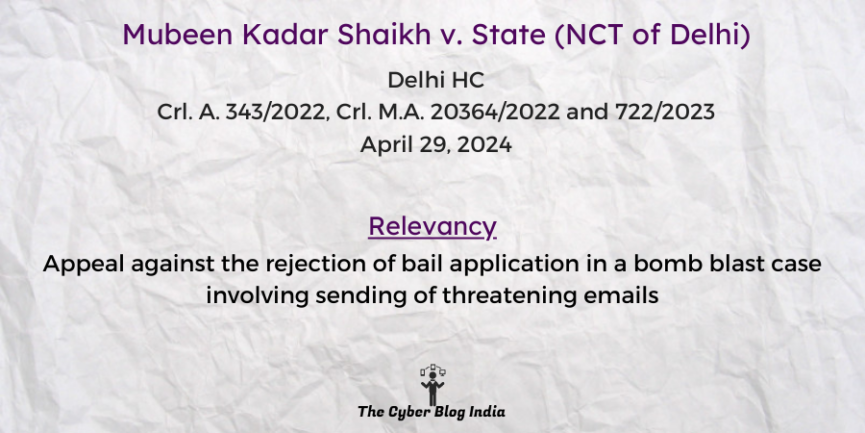Mubeen Kadar Shaikh v. State (NCT of Delhi)

Mubeen Kadar Shaikh v. State (NCT of Delhi)
In the High Court of Delhi
Crl. A. 343/2022, Crl. M.A. 20364/2022 and 722/2023
Before Justice SK Kait and Justice Shalinder Kaur
Decided on April 29, 2024
Relevancy of the case: Appeal against the rejection of bail application in a bomb blast case involving sending of threatening emails
Statutes and Provisions Involved
- The Unlawful Activities (Prevention) Act, 1967 (Section 43D(5))
- The Maharashtra Control of Organized Crime Act, 1999 (Section 18)
- The National Investigation Agency Act, 2008 (Section 21(4))
- The Information Technology Act, 2000 (Section 66)
- The Indian Penal Code, 1860 (Section 120B, 121, 121A, 122, 123, 302, 307, 323, 427)
- The Explosive Substances Act, 1908 (Section 3, 4, 5)
Relevant Facts of the Case
- On September 13, 2008, the terrorist group Indian Mujahideen sent an email titled “MESSAGE OF DEATH” to various electronic and print media outlets in Pakistan, India, and other countries. They warned of imminent bomb attacks. Also, they claimed responsibility for previous blasts in India.
- On September 23 and 24, 2008, Mumbai police arrested several accused who disclosed the involvement of the appellant and others in the Delhi bomb blasts. This led to their arrest on September 28, 2008. The police formally arrested the appellant on March 12, 2009.
- The police recovered two HCL laptops, wireless routers, adapters, a mobile phone, and a bag from the appellant. They subsequently sent them for forensic analysis.
- The prosecution filed the initial charge sheet on December 18, 2008, and five supplementary charge sheets against 14 accused individuals. They cited 610 witnesses, and the evidence collection started on May 31, 2011.
- The trial court rejected the appellant’s first and second bail applications. The court found a prima facie case against the appellant under Section 43D(5) of the Unlawful Activities (Prevention) Act, 1967.
Prominent Arguments by the Advocates
The petitioner’s counsel argued that:
- There was insufficient evidence to link the appellant to the incident or show his involvement with other co-accused.
- The Forensic Science Laboratory report indicated that the file “3.pdf” was created on September 15, 2008, and last accessed on September 30, 2008, the day of recoveries.
- The prosecution has only examined 260 out of 610 witnesses over 14 years.
- In the 2008 Ahemadabad bomb blast case, the trial court acquitted the appellant based on similar evidence. However, he had spent 13 years in judicial custody before the acquittal. There was no risk of tampering with evidence or influencing witnesses.
The respondent’s counsel submitted that:
- The prosecution argued that sufficient material linked the appellant to the conspiracy of the 2008 Delhi blasts.
- Key conspirators, including Riyaz Bhatkal and Iqbal Bhatkal, were still at large and feared the appellant might abscond or re-offend if released.
- The prosecution detailed a raid at Batla House, Delhi, on September 19, 2008, where a shootout occurred. This resulted in the arrest of an individual and the recovery of firearms and bomb-making materials.
- The appellant was part of the Indian Mujahideen’s Media Cell and was responsible for sending the warning email after hacking a Wi-Fi network. Forensic evidence linked the laptops used to the appellant and co-accused.
- Furthermore, the shop owner (PW-231) identified him as the buyer of the laptops used for mailing death threats.
Opinion of the Bench
- There was prima facie evidence linking the appellant to the Delhi blasts conspiracy and his crucial role in the Indian Mujahideen’s Media Cell.
- The appellant has a history of rejected bail applications and statutory constraints under Section 43D(5) of the Unlawful Activities (Prevention) Act, 1967.
- However, the appellant has the right to a speedy trial. The trial court should only consider these observations and findings as tentative.
Final Decision
- The bench dismissed the present appeal and the pending applications while ordering an expeditious trial.
